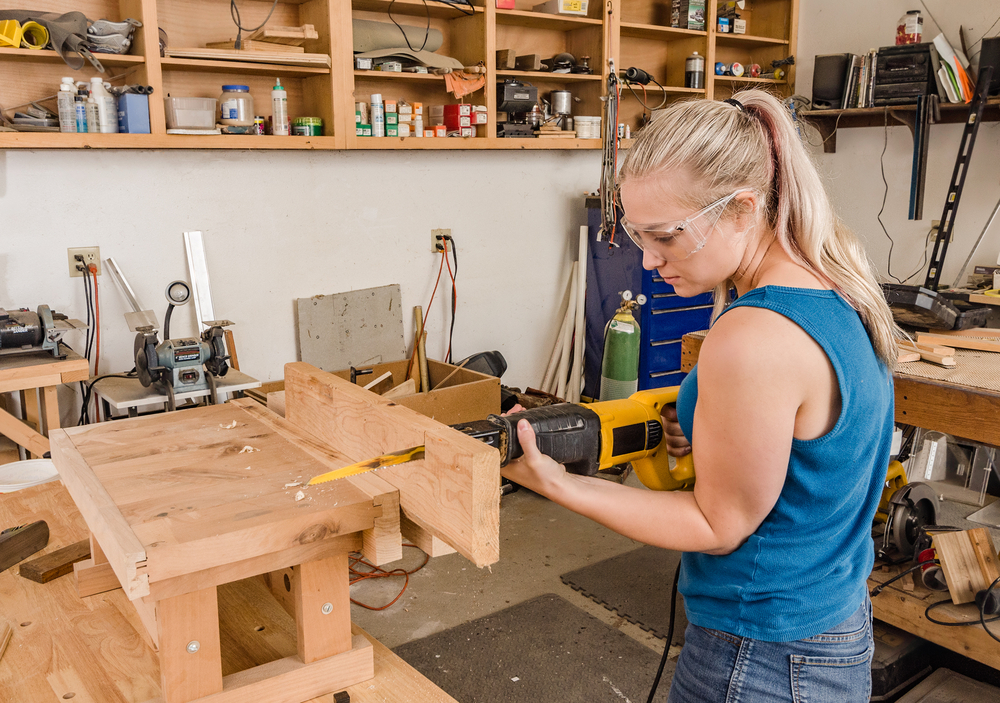Of all the tools in a craftsman’s toolbox, the reciprocating saw (sometimes called a saber saw or Sawzall) is definitely one of the most versatile and useful power tools you can own. Reciprocating saws can be used to cut through galvanized pipe, to shake the bubbles out of a concrete mold, and even to strip nails out of old reclaimed lumber. There are very few jobs in carpentry, cabinetry, plumbing, and electrical work that you can’t tackle with a good reciprocating saw.
However, before you invest in one, there are several things you should definitely know. Here’s a quick rundown of 7 things you need to know about reciprocating saws:
1. Know How Your Reciprocating Saw Works
One of the most important (and often ignored) aspects of owning a power tool is understanding how your tool functions. This is the number one cause of misuse and abuse that leads to breakage with most power tools, so take the time to educate yourself about your reciprocating saw before putting it to work. Study the moving parts and the manual so that if there is a malfunction you know what to do and potentially how to troubleshoot it.
2. Know What Jobs Are Right For Your Saw
There are very few jobs a reciprocating saw cannot handle, especially when it comes to demolition. Trimming tree limbs, , door and window frame removal before repair, and cutting into walls or drywall for electrical outlets. They are even useful for finish work on stairs where nailheads keep popping up on the tread and need to be shaved down. You can even get attachments for reciprocating saws that actually allow you to remove bathroom and floor tiles and breaking up grout. Basically, if you need something cut out or broken up, the reciprocating saw is the tool for the job.
3. Know If You Need a Reciprocating Saw
Do you do a lot of DIY projects? Are you into home improvement? Do you regularly need a saw that can cut through just about anything? You are going to need need a reciprocating saw of some kind. Larger models are great for big jobs like tree limb removal and demolition, but these may prove a bit bulky for smaller projects and overkill in terms of power. Bear in mind that smaller models are only meant for smaller jobs though too, so you want to balance your needs with capabilities and features when purchasing a saw.
4. Know What to Look For in a Reciprocating Saw
Here are the features and specs you need to look at when shopping for a reciprocating saw:
–Power: Do you want a plug-in saw or a cordless saw with a battery pack? Cordless are more versatile and can be used anywhere, but they lack the power of more powerful plug in models.
-Amperage: This is the actual power metric for the motor in your saw. Most people are just fine with a 7.5 amp motor, and that is on the low end of the power curve for these saws. If you intend to use this saw for heavy-duty demolition work, you will want something more powerful.
-Stroke Length: A measure of how far the blade travels on each cycle. The longer the travel length, the more teeth that are cutting and the faster you will get through whatever you are sawing. Most saws are 7/8th of an inch to 1 ⅛ of an inch, so there really isn’t too much difference.
-Speed: Higher strokes-per-minute means faster cutting.
5. Know and Understand the Blade Changing Mechanism
Any good reciprocating saw is not going to need any additional tools to change out the blade. Blades need frequent changing if you use the saw regularly, and if you break a blade (which happens to everyone eventually) you need to be able to pop a fresh blade in place quickly and easily.
6. Know If You Can Handle the Weight of Your Reciprocating Saw
Make sure if you can to check how much the saw weighs before purchasing one and give it a heft or a lift. Balance and weight are going to be key to how easy it is to maneuver the saw when you are using it, and you don’t want it to be a struggle just to hold the saw in place.
7. Know What Optional Features are Important to You
Here are a few features that may interest those who are investing in a reciprocating saw who may want more options in the future:
–Orbital Cutting Mode: This adds a circular motion to the cutting blade which can prove extremely useful with certain types of cutting, particularly for demolition.
-Easy-Adjust Shoe: Let’ you manage cutting depth
-Variable Speed Adjustment: Makes cutting different materials easier.
Overall, a reciprocating saw makes an extremely valuable addition to any home craftsmen’s toolkit, and greatly expands your ability to take care of more home repair and renovation projects yourself. Shop around for the best fit for your needs, and enjoy the many benefits of having a reciprocating saw available for use in and around your home any time you need it.

